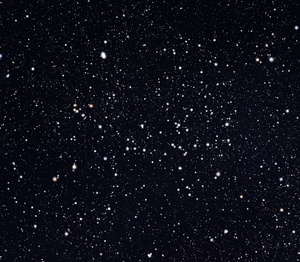2nd floor

|
|
| 2nd floor | |
| AladinLite | |
| Constellation | Cassiopeia |
|
Position equinox : J2000.0 |
|
|---|---|
| Right ascension | 02 h 14 m 43 s |
| declination | + 59 ° 29 ′ 06 ″ |
| Appearance
|
|
| classification | I 2 m |
| Angular expansion | 45 ' |
| Number of stars | 200 |
| Physical data
|
|
| distance | 988 ly (303 pc ) |
| Age | 170 million years |
| history | |
| Catalog names | |
| C 0211 + 590 • Cl Stock 2 • OCl 348 KPR2004b 28 • KPS2012 MWSC 0173 | |
Stick 2 or Muscle Man is an open star cluster in the constellation Cassiopeia (Cas) . It owes its alternative name to the special arrangement of some of its bright stars, which is reminiscent of the shape of a weight lifter. The star cluster is named after the German astronomer Jürgen Stock (1923-2004). He bears the number 2 in his 1954 catalog of 24 star collections.
The star cluster appears about 1 ° in size and is located about 2 ° north-north-east of the known double star clusters h (NGC 869) and (NGC 884) Persei. It is about 988 light years (303 pc ) away, making it about 5 pc in diameter. In the northern hemisphere, the star cluster is circumpolar up to medium latitudes and can best be observed between October and March.
It is located in the Orion arm of the Milky Way close to various molecular clouds that obscure the area between the constellations Cassiopeia and Giraffe . Analysis of the spectral classes of its stars has found many stars of classes A and F and comparatively few stars of classes O and B. Therefore, its age is given as around 170 million years.
Observation in amateur astronomy
The star cluster lies in a dense star field and appears there more as a condensation than as an open star cluster. It is accessible to observers of all levels of experience. Similar to the "owl cluster" ( NGC 457 ), the muscular man is a popular object on star tours, as it arouses the enthusiasm of amateur observers due to the arrangement of the stars. The muscular man can also be photographed with simple equipment, such as a 50 mm lens on a reflex camera, for example at ISO 1600 and f / 2.8 with an exposure time of 5 seconds.
With the 10x50 binoculars you can already observe several dozen stars of the 8th to 9th order of magnitude, which extend in an east-west direction. Even at 20x magnification and with relatively small telescopes (e.g. 88 mm), the individual stars can be clearly resolved and the star pattern can be seen. In the 120 mm telescope, several hundred stars up to the 12th order of magnitude can be seen under good conditions. From approx. 70x magnification, the visible structure of the star cluster disappears and the distinctive star pattern dissolves.
Individual evidence
- ↑ a b c SIMBAD query
- ↑ Martin Schoenball: Star cluster in Cassiopeia. Retrieved December 4, 2016 .
- ↑ WEBDA. Retrieved December 4, 2016 .
- ↑ SuW 01.2017, page 43
- ↑ Krzeminski, W .; Serkowski, K .: Photometric and Polarimetric Observations of the Nearby Strongly Reddened Open Cluster Stock 2 . In: Astrophysical Journal . tape 147 , March 1967, p. 988 , doi : 10.1086 / 149089 , bibcode : 1967ApJ ... 147..988K .
- ↑ Star party in Sollenau. In: NEMO October 17, 2003, accessed January 9, 2017 .
- ^ "Cassiopeia: Constellation Photography Without a Telescope". In: sternsucher.com. April 19, 2015. Retrieved January 9, 2017 .
- ^ "Frank" (nickname): Floor 2 (muscle man) in the Cassiopeia. Retrieved January 9, 2017 .
- ↑ November 2011. In: Staufen AstroPraxis. November 2011, accessed January 9, 2017 .
